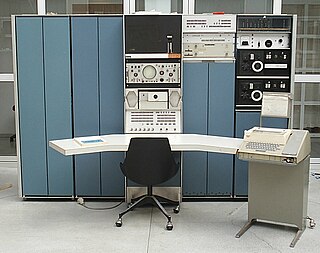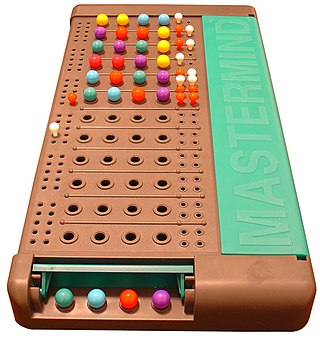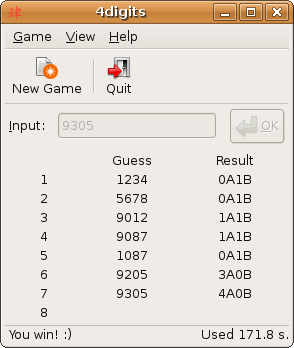B is a programming language developed at Bell Labs circa 1969 by Ken Thompson and Dennis Ritchie.

Hangman is a guessing game for two or more players. One player thinks of a word, phrase, or sentence and the other(s) tries to guess it by suggesting letters or numbers within a certain number of guesses. Originally a paper-and-pencil game, there are now electronic versions.

Multics is an influential early time-sharing operating system based on the concept of a single-level memory. Nathan Gregory writes that Multics "has influenced all modern operating systems since, from microcomputers to mainframes."

The PDP-7 is an 18-bit minicomputer produced by Digital Equipment Corporation as part of the PDP series. Introduced in 1964, shipped since 1965, it was the first to use their Flip-Chip technology. With a cost of US$72,000, it was cheap but powerful by the standards of the time. The PDP-7 is the third of Digital's 18-bit machines, with essentially the same instruction set architecture as the PDP-4 and the PDP-9.
MAD is a programming language and compiler for the IBM 704 and later the IBM 709, IBM 7090, IBM 7040, UNIVAC 1107, UNIVAC 1108, Philco 210-211, and eventually IBM System/370 mainframe computers. Developed in 1959 at the University of Michigan by Bernard Galler, Bruce Arden and Robert M. Graham, MAD is a variant of the ALGOL language. It was widely used to teach programming at colleges and universities during the 1960s and played a minor role in the development of Compatible Time-Sharing System (CTSS), Multics, and the Michigan Terminal System computer operating systems. The original version of the chatbot ELIZA was written in MAD-SLIP.
The Honeywell 6000 series computers were rebadged versions of General Electric's 600-series mainframes manufactured by Honeywell International, Inc. from 1970 to 1989. Honeywell acquired the line when it purchased GE's computer division in 1970 and continued to develop them under a variety of names for many years. In 1989, Honeywell sold its computer division to the French company Groupe Bull who continued to market compatible machines.
TYPSET is an early document editor that was used with the 1964-released RUNOFF program, one of the earliest text formatting programs to see significant use.

General Comprehensive Operating System is a family of operating systems oriented toward the 36-bit GE-600 series and Honeywell 6000 series mainframe computers.

Jotto is a code-breaking pen and paper word game for two players. Each player picks and writes down a secret word and attempts to guess the other's word first during their turn.

Mastermind or Master Mind is a code-breaking game for two players invented in Israel. It resembles an earlier pencil and paper game called Bulls and Cows that may date back a century.

Lingo is an American television game show with multiple international adaptations. In it, contestants compete to decode five-letter words given the first letter, similarly to Jotto, with each correctly guessed word earning number draws to attempt filling in a Bingo card.

Space Travel is an early video game developed by Ken Thompson in 1969 that simulates travel in the Solar System. The player flies their ship around a two-dimensional scale model of the Solar System with no objectives other than to attempt to land on various planets and moons. The player can move and turn the ship, and adjust the overall speed by adjusting the scale of the simulation. The ship is affected by the single strongest gravitational pull of the astronomical bodies.

The history of Unix dates back to the mid-1960s, when the Massachusetts Institute of Technology, AT&T Bell Labs, and General Electric were jointly developing an experimental time-sharing operating system called Multics for the GE-645 mainframe. Multics introduced many innovations, but also had many problems. Bell Labs, frustrated by the size and complexity of Multics but not its aims, slowly pulled out of the project. Their last researchers to leave Multics – among them Ken Thompson, Dennis Ritchie, Doug McIlroy, and Joe Ossanna – decided to redo the work, but on a much smaller scale.
Letter frequency is the number of times letters of the alphabet appear on average in written language. Letter frequency analysis dates back to the Arab mathematician Al-Kindi, who formally developed the method to break ciphers. Letter frequency analysis gained importance in Europe with the development of movable type in 1450 AD, where one must estimate the amount of type required for each letterform. Linguists use letter frequency analysis as a rudimentary technique for language identification, where it is particularly effective as an indication of whether an unknown writing system is alphabetic, syllabic, or ideographic.
Lingo is a British game show based on the American programme of the same name, the original iteration of the programme was made by Thames Television and Action Time for ITV, running for a single series with host Martin Daniels from 12 May to 14 July 1988. A revived version has also aired from 1 January 2021 hosted by Adil Ray.

Beagle Bag is a collection of video games for the Apple II family of computers published in 1982 by Beagle Bros Software. In common with their other titles, the Beagle Bag software was released in unlocked and unprotected form, and is now in the public domain.
Mainframe computers are computers used primarily by businesses and academic institutions for large-scale processes. Before personal computers, first termed microcomputers, became widely available to the general public in the 1970s, the computing industry was composed of mainframe computers and the relatively smaller and cheaper minicomputer variant. During the mid to late 1960s, many early video games were programmed on these computers. Developed prior to the rise of the commercial video game industry in the early 1970s, these early mainframe games were generally written by students or employees at large corporations in a machine or assembly language that could only be understood by the specific machine or computer type they were developed on. While many of these games were lost as older computers were discontinued, some of them were ported to high-level computer languages like BASIC, had expanded versions later released for personal computers, or were recreated for bulletin board systems years later, thus influencing future games and developers.
Wordle is a web-based word game created and developed by Welsh software engineer Josh Wardle. Players have six attempts to guess a five-letter word, with feedback given for each guess in the form of colored tiles indicating when letters match or occupy the correct position. The mechanics are similar to the 1955 pen-and-paper game Jotto and the television game show franchise Lingo. Wordle has a single daily solution, with all players attempting to guess the same word.
Josh Wardle is a Welsh software engineer who developed the viral web-based word game Wordle. The New York Times Company acquired Wordle from Wardle in late January 2022. Wardle lives in Brooklyn, New York.










